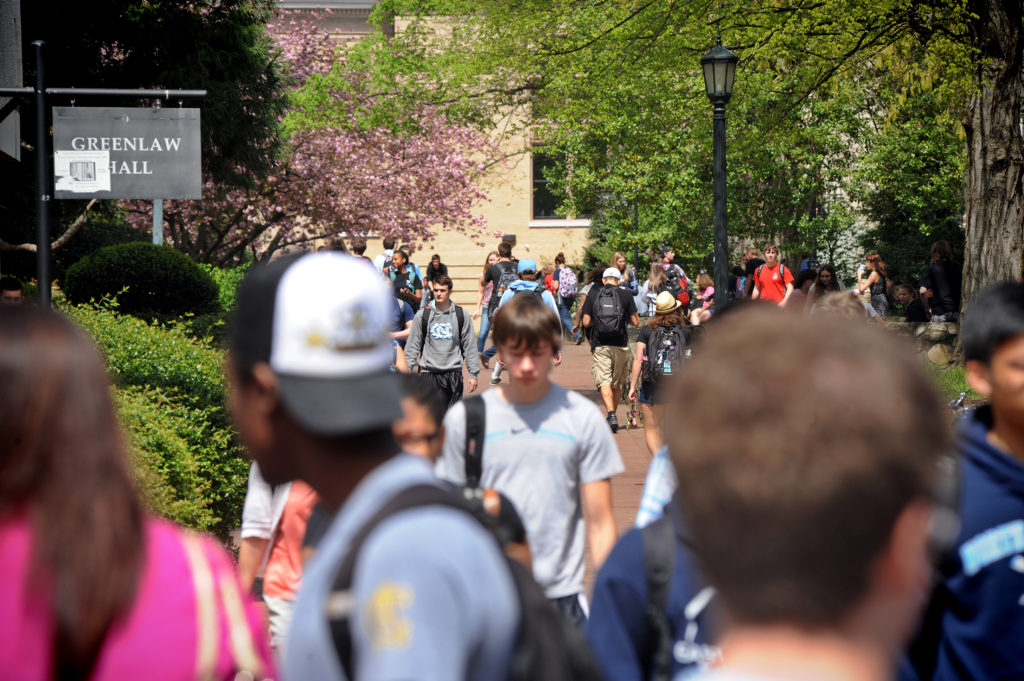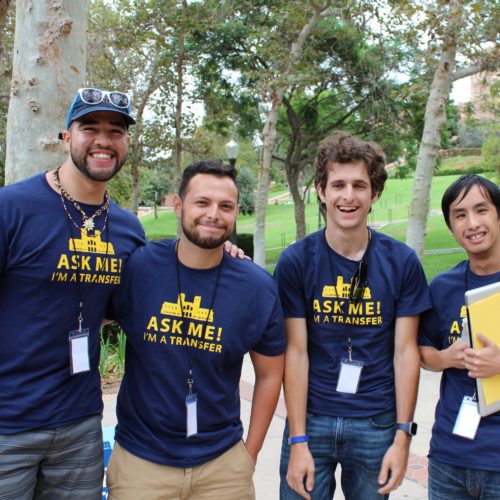Public universities nationwide have excelled in recruiting and admitting large numbers of community college transfer students: roughly 300,000 a year, about four times the number that private institutions enroll.
For many of those students, however, the transition to this new environment is rattling, marked by larger classes with less flexible schedules or course loads. If they are working parents or juggling other life responsibilities beyond being a student, they may be hard-pressed to find resources relevant to their needs, particularly at a university structured to serve residential or first-time, full-time students.
For public universities committed to enrolling hundreds, even thousands, of diverse community college students every year, it is imperative that they recognize who their students are and how to best engage and support them. To start, the average age of community college students nationally is 28, with a majority from low-income households and among the first in their family to attend college.
Too often, leaders, faculty, and staff at public universities do not understand the varied experiences transfer students bring to their campuses—or they fail to recognize the obstacles that their institutional practices and policies may inadvertently perpetuate. The responsibility for ensuring the success of transfer students at large public universities is diffused in ways that often leave students on their own to navigate those challenges, on top of the many obligations they must fulfill outside the classroom.
To excel, transfer students need clearly defined systems that offer support from before they enroll to the time they graduate and beyond. Building this kind of transfer-friendly ecosystem requires investment from, engagement with, and coordination among stakeholders across campus: from the president and cabinet to student services staff, faculty, and transfer students themselves.
Senior Leaders: Establishing a Commitment to Transfer from the Top
Universities doing the best work on transfer have senior leaders who clearly demonstrate, in a variety of ways, that transfer matters. One way to affirm this commitment is to establish high-profile joint admission partnerships, like George Mason University and Northern Virginia Community College’s ADVANCE program. Another is to set expectations and provide dedicated resources and time for deans and professors to collaborate regularly with local community college faculty on issues such as curricular alignment and credit transfer.
Organizational changes, too, can reflect an institution’s prioritization of transfer, such as the appointment of a dedicated professional, at the director level or above, whose job it is to always place transfer front and center; especially where transfer students make up a substantial portion of enrollment. A transfer director can pay close attention to the student experience across academics and student affairs, ensure the needs of transfer students are considered in policies and practices, and develop a common understanding across all units on campus of the processes that transfer students navigate—and the resources they require to do so successfully. This prevents a frequent problem from arising: contradictory messages emerging about which credits transfer, how long transfer students can remain at the university, and numerous other key issues.
The responsibility for improving transfer, however, cannot rest on one person’s shoulders. At the most transfer-friendly public universities, leaders are increasingly funding transfer centers, a central hub where students can find resources, advising, and community-building activities all in one place. Even if schools can’t create a dedicated, permanent space, they can develop “pop-up” opportunities, like the University of California-San Diego recently did, in the form of meetups around campus and, during the pandemic, virtual drop-in centers.
Faculty: Engaging Transfer Students in the Classroom and Beyond
Faculty engagement is also crucial for transfer student success. Behind the scenes, when professors and academic leaders plan and communicate with their counterparts at feeder community colleges, students are far more likely to have their credits transfer smoothly and arrive in upper-division courses with the skills and knowledge they need. Just as important, research shows that transfer students are more likely to succeed in their four-year colleges when faculty engage with them meaningfully and intentionally as mentors, research partners, and advocates; both before and after they transfer.
This impact is evident at Appalachian State University in North Carolina, where faculty mentors are connected with prospective and current transfer students; trained to influence, encourage, and guide them through their academic journeys; and beneficiaries of ongoing professional development from the Office of Transfer Services. These training sessions help to dispel misconceptions about transfers and offer concrete strategies to develop a more effective support system for transfers, beginning with simple gestures like the display of a sticker on their office door that highlights their role as a transfer advocate. Upon seeing it, students may feel more at ease asking these advocates for help when they need it.
Student Services Staff: Strengthening the Transfer Support Network
Because student service professionals and advisors are primarily responsible for helping transfer students navigate the university and access the supports they may need, their engagement is also essential in building a truly transfer-friendly institution. Like faculty mentors, they, too, would benefit greatly from transfer advocacy or inclusivity training programs, like those developed by transfer staff at UC-San Diego and University of North Carolina, Wilmington, both of which provide insight into the transfer community, who transfer students are, where they transfer from, what their transition to the university is like, and the ways in which staff can actively cultivate a more transfer-inclusive campus culture. Programs like these equip staff with actionable, up-to-date tools and knowledge that they can use in their direct interactions with transfers, helping to diminish stigma, elitism, and assumptions made regarding the community college transfer experience.
For example, admissions staff who participated in transfer awareness training at UCLA realized that campus tours were not as inclusive of the transfer student experience as they could be. As a result, they restructured the tour to include transfer-specific resources, provide student tour guides with information on transfer student services and transfer-inclusive language, and ensure that all student tour guides participate in annual transfer advocacy training to make this shift as seamless as possible.
Another step to help empower staff to support transfer students is to encourage cross-division collaboration and information-sharing. Collaboration does not have to be complicated to be effective. This can take the form of an activity as simple as a jointly held information session designed to help students understand a specific resource or navigate academic, professional, or social aspects of the campus experience. As an example, librarians can work with academic advisors and transfer center staff to provide transfer-specific tours of the library to incoming transfer students, some of whom may never have used a research library.
More formally, educators and institutional leaders might encourage the development of a transfer-specific success team or task force like those at University of Maryland, University of Minnesota, and North Carolina State University, charged with sharing information about, and collectively addressing, practices and policies that cause barriers for transfers. These teams should be comprised of staff from departments across campus such as academic advising, financial aid, admissions, residential life, and others relevant to the university’s transfer community. Additionally, they can advocate for transfer resources where none exist, streamline processes that impede the transfer journey, or simply ensure that students receive consistent messages about academic policies, no matter who they talk to on campus.
Students: Elevating the Transfer Student Voice
Perhaps the most powerful way to mobilize stakeholders across campus around the importance of transfer is to activate students themselves. After all, the thousands of students who transfer to public universities each year are the experts in traversing the transfer experience. Simply put, students listen to other students. Therefore, institutions should set up dedicated platforms and leadership opportunities that elevate transfer student voice and input, whether through transfer student advisory boards, transfer-specific student government positions, student organizations, and/or peer mentorship programs.
UCLA’s Transfer Leadership Coalition and Transfer Student Representatives Office for example, are student-run advisory and advocacy groups that collaborate with the university’s transfer center and campus leaders, provide insight and feedback on the transfer student experience, address institutional practices and policies that aren’t transfer-friendly, and seek to increase transfer representation across campus. The activism of these and other transfer-specific organizations spurred the administration to increase investments and support for initiatives like the transfer center; a peer-to-peer transfer mentorship program; transfer-specific academic, professional, and social activities; and the first transfer student representative position on the University of California Student Association. In similar fashion, transfer student leadership and representation has grown across the UC system, resulting not just in additional programs and supports for transfer students, but also a broader sense of inclusion, community, and belonging.
Supporting transfer student success effectively and efficiently at scale at public universities requires engagement from the entire campus community, from tour guides to advisors, librarians to deans. Building a transfer-friendly ecosystem requires well-organized structures that provide the opportunity for collaborative conversation, partnership, and knowledge-sharing between and across departments. With appropriate resources, champions, information, and understanding, transfer students will not fall between the cracks. Rather, they’ll receive their diplomas with no wasted time or money behind them, feeling like they were right where they belonged.







